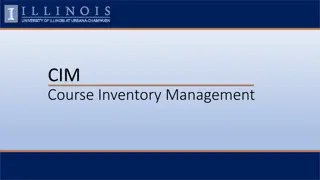Supporting Student Success in Gateway Courses
Explore a collaborative model to eliminate equity gaps in gateway courses for low-income, first-generation, and underrepresented minority students. The aim is to improve persistence and reduce disparities by focusing on grade patterns. The target is to eliminate DFW rate gaps and improve overall completion rates by partnering with colleagues and implementing change ideas.
Download Presentation

Please find below an Image/Link to download the presentation.
The content on the website is provided AS IS for your information and personal use only. It may not be sold, licensed, or shared on other websites without obtaining consent from the author. Download presentation by click this link. If you encounter any issues during the download, it is possible that the publisher has removed the file from their server.
E N D
Presentation Transcript
Moving Beyond Silos to Support Student Success in Gateway Courses Katie Russell, University of Minnesota Twin Cities Tia Freelove Kirk, APLU Leslie Schiff, University of Minnesota Twin Cities LeeAnn Melin, University of Minnesota Twin Cities
Intention What s in it for us? We are crafting a model for change, but implementation is hard. We need more insights! What s in it for you? Explore how you can partner with colleagues and leverage your role to work toward eliminating equity gaps for students
Our Improvement Aim Improve persistence and address disparities for students who are low-income, first-generation, or underrepresented minorities by eliminating equity gaps in grade patterns in gateway courses.
Our Target Success Measure Reduce DFW rate gaps between Pell and non-Pell, URM and non-URM, and first-generation and non- first-generation students to 0%, thereby decreasing overall average DFW rates.
Our Collaboration Process Brainstorm barriers Create a set of change ideas Develop a roadmap for change
Why is this our focus? DFW rates are strongly predictive of student progression and completion. Students with 1 or more DF grades are retained at a lower rate and are far less likely to graduate within 6 years than those with no DFs. https://www.aplu.org/library/powered- by-publics-learning-memo-the-big-ten- academic-alliance-cluster/file
Along the way Reviewed academic policies Gathered efforts and challenges Thematic analysis of prerequisites Centered the conversation on connecting DNFW Data with strategies for change.
Inputs/Resources Activities/Outputs Outcomes Impact Use of equity data is part of our campus DNA DATA Academic data Software to share information HUMAN RESOURCES Faculty advocate Data wrangler Data visualizer IT support DEI pedagogy expert(s) COMMUNICATION Internal process Campus plan POLICIES Campus strategic plan Department DEI Statements Existing performance policies Use of data policies INFRASTRUCTURE Active learning classrooms Data dashboards Communication with undergraduate leaders Strategies for inclusive pedagogy Data is made available and gets into the right hands Campus level data generation and communication is grounded in equity pedagogy All levels of the institution ask for the data (chancellor to coordinators) Faculty eagerly engage with data INFORM Stakeholders possess a collective responsibility for ending cycles of inequity on campus Stories about benefits of sharing data Relationships with faculty who have interest in seeing data and making improvements Staff/faculty pilot live data dashboards within courses DFW data review part of regular annual process Equity gaps, including DFWs, retention, and graduation rates, between Pell and non- Pell, URM and non- URM, and first- generation and non- first-generation students are reduced Campus stakeholders understand student outcomes in academic courses Stakeholders build desire to close identified equity gaps Stakeholders actively seek support for improving ENGAGE Campus stakeholders are equipped to implement changes when gaps are identified Learning is applied to programmatic response and instructors can make needed changes Improvements are sustained throughout staffing and departmental leadership changes Strategies for encouraging faculty to build evidence-based practices focused on improving DFW rates in the classroom Institutional stories about successes Engagement in this practice as part of DEI statements for P&T EMPOWER
A Case Study U of M and the Logic Model
What inputs/resources are you currently employing? Dashboard Development: Launched Spring 2022 Course Enrollment Long Term Trends Major/Minor Enrollment Trends Undergraduate Major/College Flow Course Difficulty (by course: average grade earned relative to a student s career GPA comparing students in x major or college to other students) Course Success and Major Affiliation (If a student takes x course, how does their outcome affect their propensity to graduate in 4 years?) Increased DNFW Awareness
What inputs/resources are you currently employing? Lessons Not all data can be delivered via a dashboard. There will always be value to ad hoc requests. Institutional history and culture currently limit who has access to these data. Data was, and still is, considered sensitive on our campus, but this is changing through efforts to acculturate faculty and administrators. Roadblocks Human resource limitations coupled with competing priorities/interests. Consumers of this information don t know what to do with the data. What action should be taken?
Informing Stakeholders of Course-Level Data and Equity Gaps DNFW Rate Equity Gap Sharing disaggregated data by legal sex, race/ethnicity, and transfer/first-year entry type. We have observed a disparity in student success at the course level with transfer students and students of color having higher DNFW rates than other groups of students. Co-requisite Courses
Informing Stakeholders of Course-Level Data and Equity Gaps Lessons Stakeholders become increasingly engaged in addressing DNFW rates when they see disproportionate DNFW rates within certain student demographic groups. The majority of faculty have expressed deep concern regarding this and are committed to better understanding why certain groups of students are less likely to be successful in their courses. Roadblocks Supporting the number of faculty who see the inequity in performance data and are interested in determining next steps. A roadblock continues to be what the University can do to address achievement gaps that precede a student s entry into the University.
Engaging faculty, administrators, and stakeholders Engaging Faculty 2019 working group Sharing DNFW rates in courses by department Initiatives Piloted E Coach Summer Bridge Program: Emerge Algebraic thinking focus
Engaging faculty, administrators, and stakeholders Lessons Increased access to data requires additional conversation around how it will be used to ensure it is not misinterpreted or misused. Faculty buy-in begins with faculty being involved in developing recommendations for new projects/initiatives. Roadblock Scale. There is so much work to do, we don t have resources to tackle and support everyone and everything. There is a need to be strategic.
Empowering Stakeholders Empowering Faculty Increased access to data Dashboards Curricular Analytics working group Amplifying department/faculty success stories
Empowering Stakeholders Lesson This work can feel overwhelming, but small actions can have an impact (e.g. shifting classroom climate, adjusting course structure to impact power dynamics, teaching from a growth mindset, considering student mental health when structuring course). Roadblock Faculty capacity to focus on course performance data for large classes.























